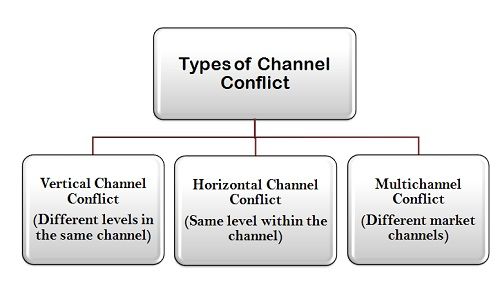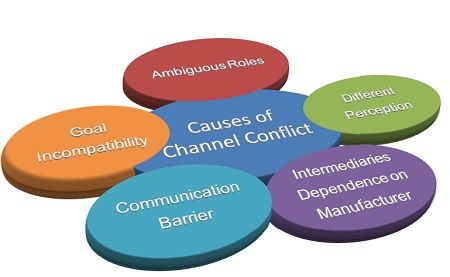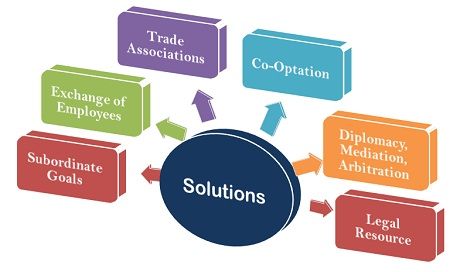Definition: The Channel Conflict arises when the channel partners such as manufacturer, wholesaler, distributor, retailer, etc. compete against each other for the common sale with the same brand.
In other words, there is a conflict among the channel partners when one prevents the other from achieving its objective. It results in a huge loss for all the partners in the channel.
Types of Channel conflict
- Vertical Channel Conflict: This type of conflict arises between the different levels in the same channel.
E.g.The conflict between the manufacturer and the wholesaler regarding price, quantity, marketing activities, etc. - Horizontal Channel Conflict: This type of conflict arises between the same level in the same channel.
E.g. The conflict between two retailers of the same manufacturer faces disparity in terms of sales target, area coverage, promotional schemes, etc. - Multichannel Conflict: This type of conflict arises between the different market channels participating in the common sale for the same brand.
E.g. If a manufacturer uses two market channels, first is the official website through which the products and services are sold. The second channel is the traditional channel i.e. through wholesaler and retailer. If the product is available at a much lower price on a website than is available with the retailer, the multichannel conflict arises.
Causes of Channel conflict
Following are some of the causes that give birth to the channel conflict:
- Goal incompatibility: Different partners in the channel of distribution have different goals that may or may not coincide with each other and thus result in conflict.
E.g. The manufacturer wants to achieve the larger market share by adopting the market penetration strategy i.e. offering a product at low price and making the profits in the long run, whereas the dealer wants to sell the product at a high cost i.e. market skimming strategy and earn huge profits in the short run.
- Ambiguous Roles: The channel partners may not have a clear picture of their role i.e. what they are supposed to do, which market to cater, what pricing strategy is to be adopted, etc.
E.g. The manufacturer may sell its products through its direct sales force in the same area where the authorized dealer is supposed to sell; this may result in the conflict.
- Different Perceptions: The channel partners may have different perceptions about the market conditions that hampers the business as a whole thereby leading to the conflict.
E.g. The manufacturer is optimistic about the change in the price of the product whereas the dealer feels the negative impact of price change on the customers.
- Manufacturer dominating the Intermediaries: The intermediaries such as the wholesaler, distributor, retailer, etc. carry the process of distribution of goods and services for the manufacturer. And if the manufacturer makes any change in the price, product, marketing activity the same has to be implemented with an immediate effect thereby reflecting the huge dependence of intermediaries on the manufacturer.
E.g. If the manufacturer changes the promotional scheme of a product with the intention to cut the cost, the retailer may find it difficult to sell the product without any promotional scheme and hence the conflict arises.
- Lack of Communication: This is one of the major reasons that lead to the conflict among the channel partners. If any partner is not communicated about any changes on time will hamper the distribution process and will result in disparity.
E.g. If retailer urgently requires the stock and the wholesaler didn’t inform him about the availability of time may lead to the conflict between the two.
Managing the Channel Conflict
In order to overcome the destructive channel conflict some solutions are listed below:
- Subordinate Goals: The channel partners must decide a single goal in terms of either increased market share, survival, profit maximization, high quality, customer satisfaction, etc. with the intention to avoid conflicts.
- Exchanging employees: one of the best ways to escape channel conflict is to swap employees between different levels i.e. two or more persons can shift to a dealer level from the manufacturer level and from wholesale level to the retailer level on a temporary basis. By doing so, everyone understands the role and operations of each other thereby reducing the role ambiguities.
- Trade associations: Another way to overcome the channel conflict is to form the association between the channel partners. This can be done through joint membership among the intermediaries. Every channel partner works as one entity and works unanimously.
- Co-optation: Under this, any leader or an expert in another organization is included in the advisory committee, board of directors, or grievance redressal committees to reduce the conflicts through their expert opinions.
- Diplomacy, Mediation and Arbitration: when the conflict becomes critical then partners have to resort to one of these methods.
In Diplomacy, the partners in the conflict send one person from each side to resolve the conflict.
In Mediation, the third person is involved who tries to resolve the conflict through his skills of conciliation.
In Arbitration, when both the parties agree to present their arguments to the arbitrator and agree to his decision.
- Legal resource: When the conflict becomes crucial and cannot be resolved through any above mentioned ways, the channel partners may decide to file a lawsuit.
Thus, it is a fundamental responsibility of every organization to maintain harmonious relations with its channel partners as the conflict between these may result in huge losses for each involved in the channel including the manufacturing company.




Asif farooq says
Really very fabolous
JAVED ALI says
Nicely explained, short and very effective
Abednego says
nice piece of writing, it really helped me in my assignment. I made serious reference.
ninsiima betty says
well explained,thanks
Shujan Ghosh, M.Com says
The most easiest way of presenting answer as mentioned in book by Philip Kotler.
Thank you author